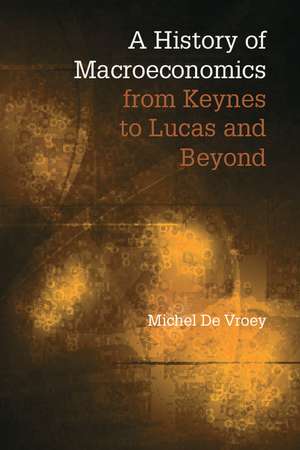A History of Macroeconomics from Keynes to Lucas and Beyond
Autor Michel De Vroeyen Limba Engleză Paperback – 6 ian 2016
| Toate formatele și edițiile | Preț | Express |
|---|---|---|
| Paperback (1) | 305.55 lei 3-5 săpt. | +28.77 lei 6-12 zile |
| Cambridge University Press – 6 ian 2016 | 305.55 lei 3-5 săpt. | +28.77 lei 6-12 zile |
| Hardback (1) | 965.75 lei 6-8 săpt. | |
| Cambridge University Press – 7 ian 2016 | 965.75 lei 6-8 săpt. |
Preț: 305.55 lei
Nou
Puncte Express: 458
Preț estimativ în valută:
58.49€ • 61.40$ • 48.31£
58.49€ • 61.40$ • 48.31£
Carte disponibilă
Livrare economică 09-23 ianuarie 25
Livrare express 25-31 decembrie pentru 38.76 lei
Preluare comenzi: 021 569.72.76
Specificații
ISBN-13: 9781107584945
ISBN-10: 1107584949
Pagini: 446
Ilustrații: 35 b/w illus.
Dimensiuni: 152 x 228 x 25 mm
Greutate: 0.61 kg
Editura: Cambridge University Press
Colecția Cambridge University Press
Locul publicării:New York, United States
ISBN-10: 1107584949
Pagini: 446
Ilustrații: 35 b/w illus.
Dimensiuni: 152 x 228 x 25 mm
Greutate: 0.61 kg
Editura: Cambridge University Press
Colecția Cambridge University Press
Locul publicării:New York, United States
Cuprins
Introduction; Part I. Keynes and Keynesian Macroeconomics: 1. Keynes's General Theory; 2. Keynesian macroeconomics; 3. The neoclassical synthesis program: Klein and Patinkin; 4. Monetarism; 5. Phelps and Friedman: the natural rate of unemployment; 6. Leijonhufvud and Clower; 7. Non-Walrasian equilibrium models; 8. Assessment; Part II. DSGE Macroeconomics: 9. Lucas and the emergence of DSGE macroeconomics; 10. A methodological breach; 11. Assessing Lucas; 12. Early reactions to Lucas; 13. Reacting to Lucas: first generation new Keynesians; 14. Reacting to Lucas: alternative research lines; 15. Real business cycle modeling: Kydland and Prescott's contribution; 16. Real business cycle modeling: critical reactions and further developments; 17. Real business cycle modeling: assessment; 18. Second generation new Keynesian modeling; Part III. A Broader Perspective: 19. The history of macroeconomics against the Marshall–Walras divide; 20. Standing up to DSGE macroeconomics; 21. Looking back, looking ahead.
Recenzii
'Michel De Vroey does not simply record what he finds. He has a vision of the kind of macroeconomics he would like to see, perhaps one he developed gradually over the years he has worked on this book. What makes this book enjoyable is that he has high hopes for economics, he flatters us that we are important, and he praises the progress we have achieved. In the end he has the integrity not to hide his disappointments, his conviction that while there is no turning back, there is still a long way to go.' Robert E. Lucas, Jr, John Dewey Distinguished Service Professor in Economics, University of Chicago
'No branch of economics has witnessed as many revolutions and counter-revolutions as macroeconomics, starting from Keynes' General Theory eighty years ago. Michel De Vroey's book provides a thorough but highly readable account of the main developments in the field over that period. It conveys a sense of the excitement generated by the advent of every new paradigm, as well as of the growing tension between the requirements of theoretical purity and those of empirical and policy relevance that macroeconomists keep facing these days.' Jordi Galí, Research Centre for International Economics (CREI), Universitat Pompeu Fabra and Barcelona Graduate School of Economics
'Macroeconomics research has largely proceeded through 'revolutions'. One wishes for a more linear and evolutionary process, one where most new contributions would naturally fit and the common core become steadily stronger. But the immense complexity of modern economies, the difficult methodological choices, may be such that 'revolutions' will keep happening, with their share of destruction, confusion, and eventual reconstruction. Understanding the nature of these revolutions is essential to understanding where we are today, and Michel De Vroey's book does a masterful job of doing just that. A thoroughly illuminating and enjoying read.' Olivier J. Blanchard, Robert M. Solow Professor of Economics, Massachusetts Institute of Technology
'Macroeconomics is a complex evolving system of thinking. Michel De Vroey's latest book dives into that evolving complexity and, by distinguishing between Marshallian and Walrasian macroeconomics, helps make the history of macroeconomics a bit more understandable. It's sad that more economists don't make that distinction.' David Colander, Distinguished College Professor, Middlebury College
'De Vroey's book reads like a travelogue recounting his life journey as a macroeconomist, and his considered response to key texts he encountered along the way. Always thoughtful and penetrating, he stimulates this reader to reflect anew on how we got to where we are today, and what might lie ahead.' Perry Mehrling, perrymehrling.com
'Michel De Vroey's interpretation of the history of macroeconomics through analysis of the most important macro models built and developed in the last decades, from Keynes's General Theory to the present days, is presented here.' Danilo Freitas Ramalho da Silva, The European Journal of the History of Economic Thought
'No branch of economics has witnessed as many revolutions and counter-revolutions as macroeconomics, starting from Keynes' General Theory eighty years ago. Michel De Vroey's book provides a thorough but highly readable account of the main developments in the field over that period. It conveys a sense of the excitement generated by the advent of every new paradigm, as well as of the growing tension between the requirements of theoretical purity and those of empirical and policy relevance that macroeconomists keep facing these days.' Jordi Galí, Research Centre for International Economics (CREI), Universitat Pompeu Fabra and Barcelona Graduate School of Economics
'Macroeconomics research has largely proceeded through 'revolutions'. One wishes for a more linear and evolutionary process, one where most new contributions would naturally fit and the common core become steadily stronger. But the immense complexity of modern economies, the difficult methodological choices, may be such that 'revolutions' will keep happening, with their share of destruction, confusion, and eventual reconstruction. Understanding the nature of these revolutions is essential to understanding where we are today, and Michel De Vroey's book does a masterful job of doing just that. A thoroughly illuminating and enjoying read.' Olivier J. Blanchard, Robert M. Solow Professor of Economics, Massachusetts Institute of Technology
'Macroeconomics is a complex evolving system of thinking. Michel De Vroey's latest book dives into that evolving complexity and, by distinguishing between Marshallian and Walrasian macroeconomics, helps make the history of macroeconomics a bit more understandable. It's sad that more economists don't make that distinction.' David Colander, Distinguished College Professor, Middlebury College
'De Vroey's book reads like a travelogue recounting his life journey as a macroeconomist, and his considered response to key texts he encountered along the way. Always thoughtful and penetrating, he stimulates this reader to reflect anew on how we got to where we are today, and what might lie ahead.' Perry Mehrling, perrymehrling.com
'Michel De Vroey's interpretation of the history of macroeconomics through analysis of the most important macro models built and developed in the last decades, from Keynes's General Theory to the present days, is presented here.' Danilo Freitas Ramalho da Silva, The European Journal of the History of Economic Thought
Notă biografică
Descriere
This book retraces the history of macroeconomics from Keynes's General Theory to the present.












